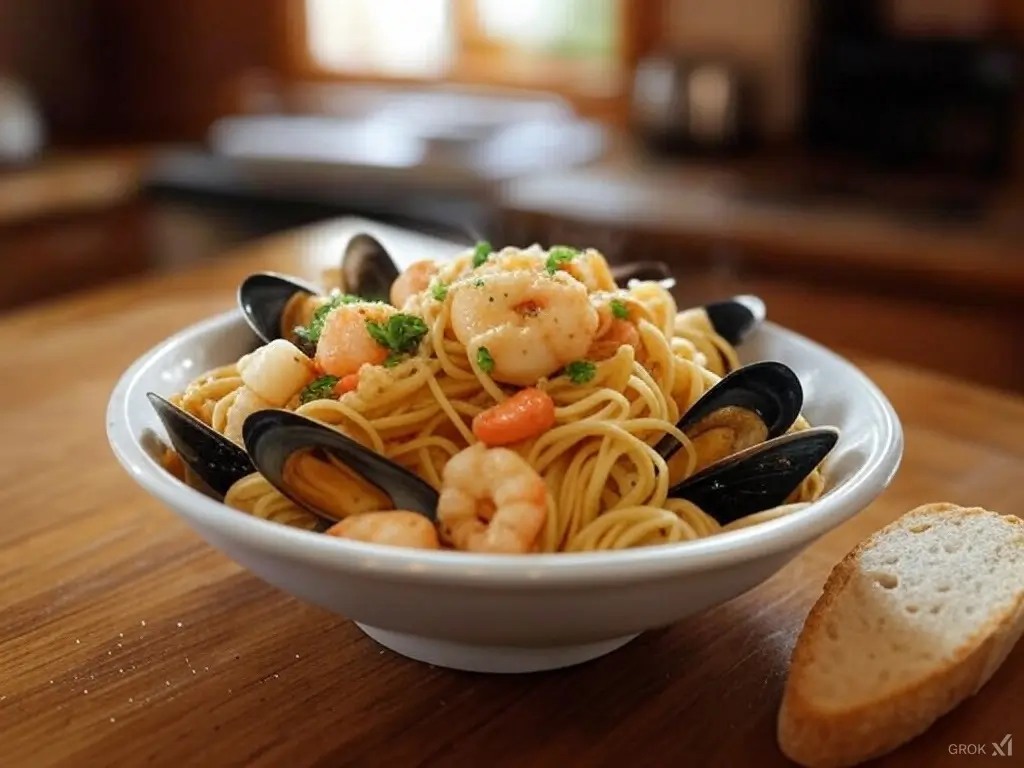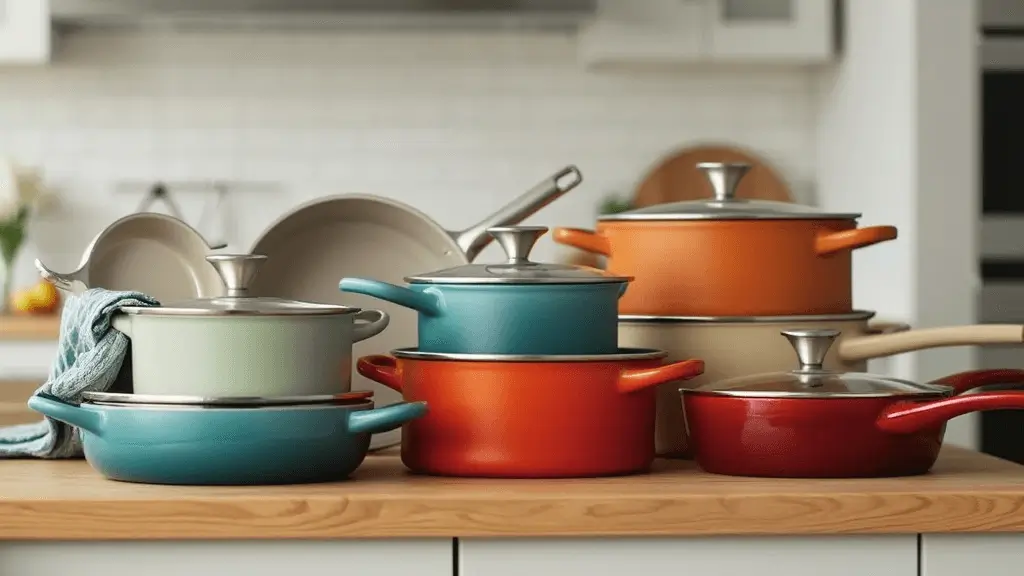In this guide, you’ll learn how to use fresh veggies and herbs from your garden. We’ll show you how to make dishes like Gargouillou and Tian Provencal. These dishes celebrate nature’s bounty. Our French food inspired by garden approach means you get healthy meals and help the planet too.
Let’s explore these wonderful recipes together. Each one is carefully made to highlight the beauty and flavor of garden-fresh ingredients. Whether you’re a pro chef or a home cook, these recipes will take your cooking to new heights.
The Art of Organic French Cuisine
Choosing organic French cuisine is more than just a food choice. It’s a celebration of realness and care for our planet. This cooking style works with nature, using fresh ingredients to boost taste and health.
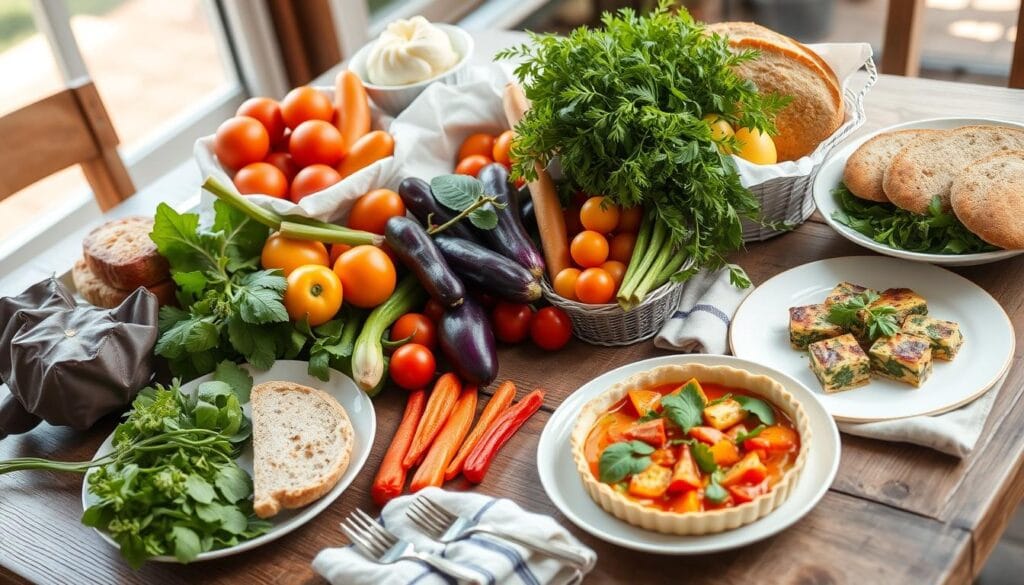
Benefits of Using Fresh Ingredients
Using fresh ingredients in French cooking is not just about taste. It’s also about being healthy and kind to our planet. Organic produce is packed with nutrients and tastes better than processed foods. It means less harm from pesticides and chemicals in your meals.
Also, buying local cuts down on carbon emissions from long trips. A 1994 survey showed 23 percent of the French fruits and veggies were grown at home. This highlights the focus on freshness and quality.
How to Source Organic Produce
Finding good organic produce means finding reliable suppliers and knowing when things are in season. Community-supported agriculture (AMAP) is key. It connects people and restaurants with local farms. This helps farmers and ensures fresh ingredients for cooking lovers.
Big distributors like Rungis also offer a wide range of organic foods in Paris. They help meet the demand for fresh market food.
Urban farming is also on the rise, with about 30% of urban French people getting involved. This shows a growing interest in buying food locally. Whether you shop at farmers’ markets or join community agriculture, choosing organic and fresh is essential for mastering organic French cuisine.
Gargouillou: A Celebration of Garden Fresh Vegetables
Gargouillou is a shining example of French cuisine’s creativity and vibrancy. It comes from Auvergne’s traditions and has grown under Chef Michel Bras’s influence. This dish has become a vibrant mix of vegetables, herbs, and flowers.
History of Gargouillou
At first, “gargouillou” was a simple dish of potatoes and ham from Auvergne. But over 40 years, it has changed a lot. Chef Michel Bras transformed it in 1980, making it a dish with up to 80 ingredients, each one carefully chosen for its flavor.
Michel Bras’ Influence on Modern French Cuisine
Chef Michel Bras’s version of Gargouillou has changed French cooking a lot. His dish has 60 different vegetables, flowers, and seeds. It’s a colorful mix of fresh garden ingredients.
Bras’s work is known for its detail and creativity. It has inspired many chefs to use local and seasonal ingredients. This dish is a celebration of the garden’s bounty.
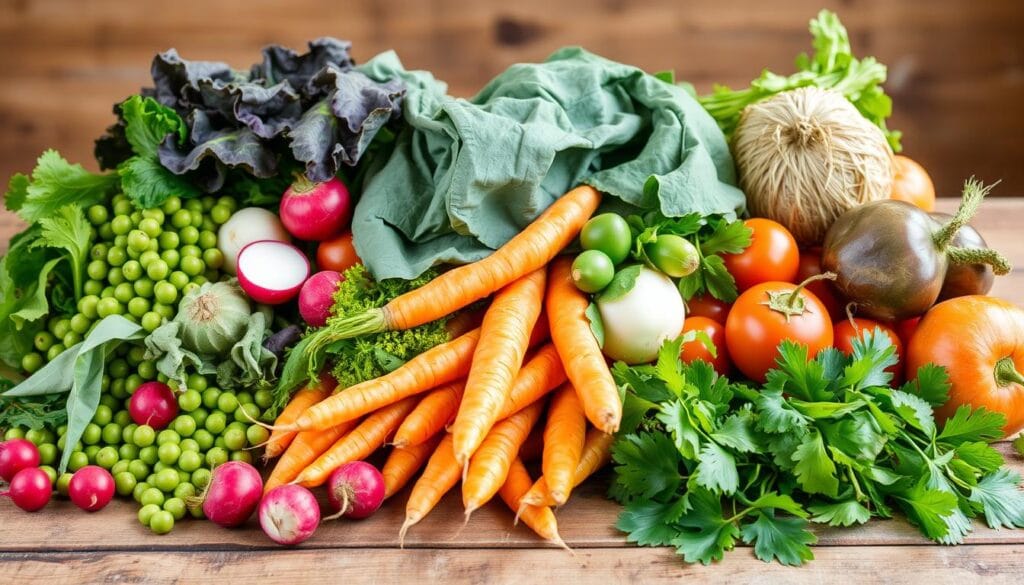
Gargouillou uses many vegetables like asparagus, fiddleheads, and carrots. These are cooked lightly to keep their flavor. Chef Bras steams parsnips in licorice water and blanches artichokes for a few minutes.
He also serves raw, thin slices of beets. This shows his care in cooking. François Chartier’s flavor pairing ideas help bring all the ingredients together.
| Ingredient | Preparation Method |
|---|---|
| Parsnips | Steamed in licorice water for 5 minutes |
| Jerusalem Artichokes | Steamed for 3 minutes |
| Beets | Served raw and thinly sliced |
| Asparagus | Blanched |
| Fiddleheads | Fresh |
Michel Bras’s work goes beyond just Gargouillou. He inspires chefs everywhere to use fresh, seasonal ingredients. Gargouillou is a beautiful tribute to the garden’s bounty, showing how nature can enhance our cooking.
Creating Your Own Gargouillou at Home
Try making the famous Gargouillou recipe at home. It was created by Michel Bras in the early 1980s. It shows how flavors can work together beautifully. With the right ingredients and care, you can make this dish yourself.
Ingredients You’ll Need
To make a real Gargouillou, you need many vegetables. Choose both seasonal and local ones. Here’s what you’ll need:
- 50 to 60 seasonal vegetables, such as tanous (cabbage shoots), tamiers, mangetout beans, bitter melon, and amaranth.
- Herbs and edible flowers.
- Olive oil and seasonings like sea salt and pepper.
- Optional: fresh peas for extra freshness.
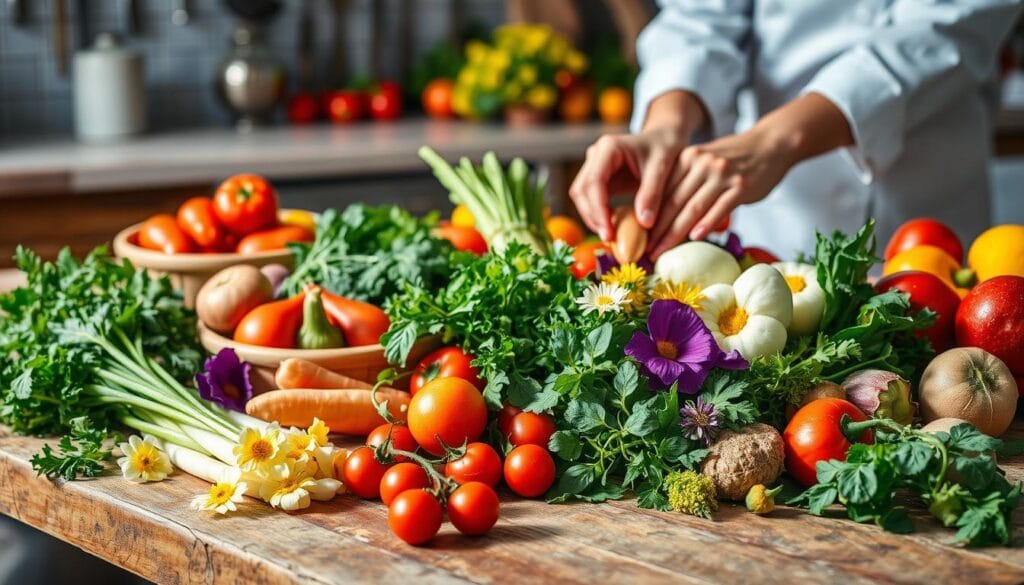
Step-by-Step Preparation Guide
Here’s how to make your own Gargouillou:
- Preparation: Start by washing all vegetables well. Cut them as needed. Blanch some greens to keep their color bright.
- Assembly: Arrange different vegetables on each plate. Try to mix colors and textures to show off the season’s best.
- Seasoning: Add a bit of olive oil and sprinkle with sea salt and pepper.
- Finishing Touch: Top with edible flowers and herbs for looks and taste.
Flavor Pairing Theories
Knowing about flavor pairing is key to making Gargouillou. It’s all about how ingredients work together. Michel Bras made it so it changes every day with new ingredients.
Here are some tips:
- Contrast and Complement: Mix sweet veggies like peas with bitter ones like bitter melon for a good taste.
- Textural Variety: Add crunchy things like amaranth with soft ones like blanched cabbage shoots for a nice feel.
- Seasonal Selection: Use the freshest ingredients you can. They taste better and help local farmers.
Tian Provencal: A Colorful Dish from Provence
Tian Provencal is a vibrant dish that celebrates Provence’s flavors and colors. It uses fresh garden ingredients in a beautiful layered pattern. This dish is a true reflection of the region’s culinary tradition, featuring summer vegetables at their best.
Traditional Ingredients
Tian Provencal includes a variety of fresh vegetables. It has five types of red tomatoes, two eggplants, and three bell peppers (red, green, and yellow). The dish uses two large red bell peppers and two long thin eggplants, all sliced thinly.
To prepare it, five tablespoons of olive oil are used. One tablespoon is for baking the peppers. The dish is baked at 450 degrees Fahrenheit first, then at 375 degrees. It takes about 1 hour and 10 minutes to bake, with different steps for roasting peppers and adding toppings.
| Ingredients | Quantity |
|---|---|
| Roma Tomatoes | 4-5, cut into 1/4 inch slices |
| Red Bell Peppers | 2, large, sliced |
| Thin Eggplants | 2, sliced |
| Fresh Thyme Leaves | 2 tbsp |
| Nonpareil Capers | 2 tbsp |
| Kosher Salt & Black Pepper | 2 tsp each |
| Italian Seasoned Panko Crumbs | 2 tbsp |
| Grated Parmesan Cheese | 1 tbsp |
| Olive Oil | 5 tbsp total |
The dish is seasoned with kosher salt, black pepper, thyme, and capers. It’s topped with panko crumbs and Parmesan cheese. Serving it warm or at room temperature brings out its bold flavors.
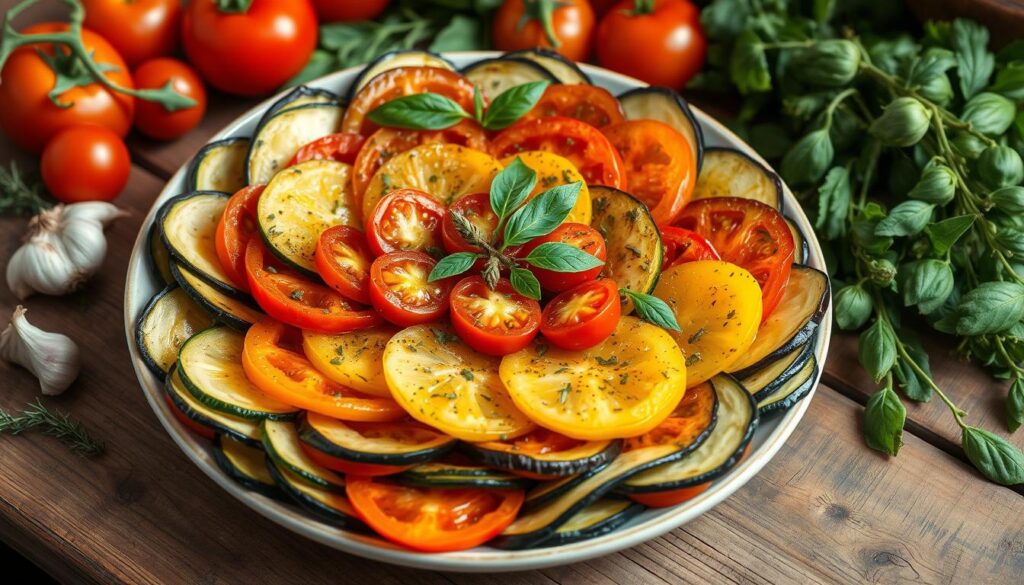
Variations of the Recipe
While the traditional Tian Provencal is great, you can try different variations. Using heirloom tomatoes can add more flavor. Adding summer squash or zucchini can also change the texture.
For a stronger taste, add fresh basil or crumbled goat cheese before baking. You can also use Herbes de Provence instead of regular seasoning. These changes make Tian Provencal even more special.
Salade Niçoise with a Garden Twist
Salade Niçoise, a French classic, gets a fresh twist with garden ingredients. It’s a vibrant dish that celebrates fresh, local produce. This salad is not just beautiful but also packed with nutrients.
To make this updated Salade Niçoise, start with 4 ounces of salad greens like Bibb or Boston lettuce. These greens add a crisp texture that contrasts well with other ingredients. Next, add 3 to 4 medium tomatoes, sliced into wedges, and 6 thinly sliced radishes for fresh flavor.
For a refreshing crunch, include 1 cucumber, peeled, halved lengthwise, and seeded. No Salade Niçoise is complete without hard-boiled eggs. This recipe calls for 4 eggs, boiled for 10 minutes to achieve the perfect texture.
Also, add 1/2 cup of pitted black olives and 1 cup of quartered canned artichoke hearts for the classic taste. For protein, use 1 (5-ounce) can of canned tuna packed in oil, drained and flaked. You can also use 2 cans of sardines or anchovies for a Mediterranean touch.
Enhance the salad with 4 thinly sliced green onions and a burst of fresh flavor from 10 torn basil leaves. The dressing, essential for bringing all these flavors together, combines 2 tablespoons of red wine vinegar and Dijon mustard each, mixed with 1/3 cup of extra virgin olive oil. This well-balanced dressing can be prepared in advance and stored in the fridge for up to 2 nights.
For the best taste, dress the salad just before serving. Slicing and salting the tomatoes in advance and allowing them to drain for 10 minutes can enhance their flavor.
The seasonal garden inspired dishes use fresh, seasonal produce. By using ingredients like 6 fresh figs or a mix of favorite lettuces and arugula, each seasonal combination includes approximately 7-10 ingredients. This results in a heart-healthy and deliciously fresh plate.
Below is a detailed table of ingredients and their preparation times to help you assemble your perfect Salade Niçoise:
| Ingredient | Quantity | Preparation Time | Storage Time |
|---|---|---|---|
| Salad Greens | 4 oz | – | Up to 5 days |
| Hard-Boiled Eggs | 4 | 10 minutes | Up to 24 hours |
| Medium Tomatoes | 3-4, sliced | 10 minutes to drain | Up to 6 hours |
| Radishes | 6, sliced | – | Up to 24 hours |
| Cucumber | 1, prepared as described | – | Up to 24 hours |
| Pitted Black Olives | 1/2 cup | – | – |
| Quartered Artichoke Hearts | 1 cup | – | – |
| Tuna, flaked | 1 (5-ounce) can | – | – |
| Green Onions | 4, sliced | – | Up to 24 hours |
| Basil Leaves | 10, torn | – | – |
| Red Wine Vinegar | 2 tbsp | – | – |
| Dijon Mustard | 2 tbsp | – | – |
| Extra Virgin Olive Oil | 1/3 cup | – | – |
Farm-to-Table French Dishes
The farm-to-table movement is changing French cuisine. It brings fresh produce straight to your plate. In France, 84% of people prefer food from local farms.
Central and western France lead in using local ingredients. Restaurants there use produce from nearby farms and markets. This shows a big commitment to local food.
Embracing Seasonal Ingredients
Using seasonal ingredients is more than a trend. It’s about connecting with the land. Organic farming is used by 60% of French farmers who sell directly to consumers.
Chef Alain Passard of l’Arpège grows over 500 types of vegetables. He grows them at Bois Girault in Normandy. The produce is delivered daily to ensure it’s fresh and flavorful.
70% of French chefs believe in using local ingredients. This not only improves the taste of dishes but also supports sustainable farming. Chef Passard’s methods reduce carbon footprints.
Delicious Recipes for Every Season
Farm-to-table French dishes change with the seasons. Restaurants update their menus to reflect what’s in season. About 90% of them do this.
Here are some seasonal dishes:
- Spring: Fresh asparagus with lemon beurre blanc.
- Summer: Tomato tart with herbes de Provence.
- Fall: Butternut squash risotto with sage.
- Winter: Root vegetable gratin.
Events like the outdoor market in La Rochelle celebrate these dishes. They attract local shoppers and create a lively community. Restaurants near markets see a 30% increase in customers during festivals.
| Season | Signature Dish | Ingredients |
|---|---|---|
| Spring | Fresh Asparagus with Lemon Beurre Blanc | Asparagus, lemon, butter |
| Summer | Tomato Tart with Herbes de Provence | Tomatoes, puff pastry, herbs |
| Fall | Butternut Squash Risotto with Sage | Butternut squash, arborio rice, sage |
| Winter | Root Vegetable Gratin | Potatoes, parsnips, carrots, cream |
Farm-to-table gardens, like Le Barn’s 27,000 square feet, show a dedication to fresh produce. These gardens provide ingredients for chefs all year. Events like Chef Daniel Joly’s farm-to-table dinners at Mirabelle highlight this movement. They connect the food we eat to the land it comes from, making meals more enjoyable.
Sustainable French Food Practices
Modern French cooking values sustainable practices. These practices keep traditions alive while caring for the environment. Chefs now choose to reduce waste, use local ingredients, and lessen their environmental footprint.
Importance of Sustainability in French Cooking
French chefs are focusing on sustainability. Bertrand Grébaut at Septime aims to use less than 20% animal protein. This move saves resources and promotes plant-based meals.
At La Chassagnette, over 200 fruits and vegetables are harvested each year. This shows a dedication to biodiversity and fresh produce. Chef Alain Ducasse’s natural cuisine celebrates natural, unprocessed ingredients, marking its fifth year in Paris.
Here are some notable sustainable practices from French restaurants:
| Restaurant | Sustainable Practice |
|---|---|
| Septime | Less than 20% animal protein in meals |
| La Chassagnette | Harvests over 200 types of fruits and vegetables annually |
| Elsa | First Michelin star for 100% organic restaurant |
| L’Épi Dupin | Uses three separate compost heaps |
| Château Villandry | Uses two planting cycles annually with 40 different species |
Fresh Ingredients in French Cooking
French cuisine is famous for its careful use of fresh ingredients. These ingredients are the heart of any real French dish. Using garden-fresh produce boosts flavors and makes meals healthier. Let’s explore some key elements:
| Ingredient | Role | Usage |
|---|---|---|
| Garlic | Flavor Enhancer | Marinades, Sauteed, Roasted |
| Herbs de Provence | Flavor Infusion | Soups, Stews, Grilled Meats |
| Butter | Richness and Texture | Sauces, Pastries, Frying |
| Olive Oil | Fat Base | Dressings, Marinades, Sauteing |
| Onions | Sweetness and Umami | Sauces, Soups, Bases |
| Red & White Wines | Flavor Enhancement | Deglazing, Sauces |
| Homemade Chicken Stock | Savory Base | Soups, Stews, Sauces |
| Cheese (e.g., Brie & Roquefort) | Flavor and Texture | Gratins, Soufflés |
| Mushrooms (e.g., Chanterelles & Porcini) | Earthiness | Sauces, Soups, Meats |
| Potatoes | Versatility | Mashed, Roasted, Gratins |
From garlic’s strong flavor to Herbs de Provence’s subtle notes, each ingredient has its own role. Fresh ingredients are crucial for true French cooking. The creamy butter, deep homemade stocks, and local wines add complex flavors that are unmatched.
Using fresh ingredients from local gardens is a cherished tradition in French cooking. It keeps French recipes authentic and supports a healthier lifestyle. By following these principles, you can turn simple meals into culinary wonders.
French Culinary Garden Influence
The French culinary garden has deeply shaped cooking, mixing beauty with usefulness. It combines nature and food, making flavors in both old and new French recipes better. The garden’s focus on growing herbs and veggies means fresh, tasty ingredients go straight from the earth to your plate.
Incorporating Garden Herbs
Herbs are key in the French culinary garden. Thyme, rosemary, lavender, and tarragon add amazing scents to dishes. Lavender, for example, grows best in zones 5 to 9, showing the best climates for it.
Using these herbs not only makes food taste better but also keeps the recipes true to their garden roots.
- Thyme: Often used for seasoning meats, soups, and stews.
- Rosemary: Known for its pungent fragrance, it’s perfect for roasted lamb and poultry.
- Lavender: Offers a subtle floral note to desserts and savory dishes.
- Tarragon: Essential for classic French béarnaise sauce.
Using Vegetables Straight from the Garden
The French culinary garden’s magic is in its fresh veggies. This method ensures food is at its best, full of nutrients. Carrots, radishes, and zucchinis are key in many French recipes.
Here’s a look at how fresh veggies impact French cooking:
| Vegetable | Traditional Use | Garden-Influenced Use |
|---|---|---|
| Carrots | Soups and stews | Raw in salads, steamed with herbs |
| Radishes | Garnish for plates | Fresh in salads, roasted with butter |
| Zucchinis | Grilled or fried | Sliced thin in a tian or baked with cheese |
The French culinary garden’s impact goes from old traditions to new, green ways. It shows how fresh food from the garden makes dishes taste better and is healthier.
Creating Seasonal Garden Inspired Dishes
Make the most of each season by cooking up delicious garden-inspired meals. Use your garden’s fresh ingredients all year round. This way, you can enjoy tasty and eco-friendly meals.
Spring and Summer Recipes
Spring and summer bring a burst of fresh, colorful produce. These ingredients can turn any meal into a feast. Here are some seasonal garden inspired dishes for these seasons.
- Spring Salad: Mix 500g of peas and broad beans with roasted asparagus, radishes, and spring onions. Add a light 125ml of oil and 325ml of rosé wine for a refreshing taste.
- Poached Rhubarb: Poach 4 stems of rhubarb, cut into 5cm pieces, in 200ml rosé wine. It’s a great topping for desserts.
- Quick Pickled Vegetables: Fill a 500ml jar with seasonal veggies, 450ml vinegar, 3 tsp salt, and 200ml water. It’s a crunchy side dish.
- Garden Fresh Potato Salad: Blend 500g of new potatoes with fresh herbs like basil and oregano. Dress with a light vinaigrette.
Fall and Winter Recipes
The cooler months bring their own flavors. Try these cozy seasonal garden inspired dishes to warm up any day.
- Roasted Root Vegetables: Roast carrots, parsnips, and sweet potatoes until tender. It’s a comforting side dish.
- Pickled Rhubarb: Slice rhubarb and pickle it with 250ml red wine vinegar, 2 tsp salt, and 100g (or 50g if using sweet cicely) sugar. It’s tangy and tasty.
- Warm Lentil Salad: Cook lentils with winter greens like kale and chard. Dress with a simple vinaigrette.
- Hearty Vegetable Stew: Mix various garden vegetables in a rich broth. Season with rosemary and thyme for a fulfilling meal.
| Season | Recipe | Ingredients | Cooking Time |
|---|---|---|---|
| Spring & Summer | Spring Salad | 500g peas, asparagus, 125ml oil, 325ml rosé wine | 10 minutes prep |
| Spring & Summer | Poached Rhubarb | 4 stems rhubarb, 200ml rosé wine | 15 minutes |
| Fall & Winter | Roasted Root Vegetables | Carrots, parsnips, sweet potatoes | 30-40 minutes |
| Fall & Winter | Pickled Rhubarb | 250ml red wine vinegar, 100g sugar | 20 minutes prep, 1 week for pickling |
Enjoy the vibrant tastes of spring and summer or the cozy warmth of fall and winter. These seasonal garden inspired dishes bring the essence of each season into your kitchen.
The Beauty of French Baked Summer Vegetables
French cuisine loves the fresh taste of summer vegetables. Dishes like zucchini, eggplant, and tomatoes show off summer’s best. These vegetables get even better with simple baking methods.
Recipes Featuring Zucchini, Eggplant, and Tomatoes
Let’s explore a classic French dish: the Tian Provencal.
Ingredients:
- 2 tablespoons of unsalted butter
- 4 medium-sized sweet onions, thinly sliced
- 1 large yellow summer zucchini, sliced
- 1 large green zucchini, sliced
- 1 large eggplant, halved lengthwise
- 4 large tomatoes, cored and halved lengthwise
- 4 cloves of garlic, finely chopped
- 1/4 cup of extra-virgin olive oil
- 2 tablespoons of Herbes de Provence
- 4 sprigs of fresh thyme
- Fine sea salt and freshly ground pepper to taste
Instructions:
- Preheat your oven to 400°F.
- Caramelize the onions in unsalted butter over medium heat for about 25 minutes.
- Arrange the sliced zucchini, eggplant, and tomatoes in a baking dish, layering them alternately.
- Sprinkle the caramelized onions and chopped garlic evenly over the vegetables.
- Drizzle with extra-virgin olive oil and season with Herbes de Provence, fresh thyme, salt, and pepper.
- Cover the dish with foil and bake for 15 minutes.
- Remove the foil and bake uncovered for an additional 25 minutes until the vegetables are tender and caramelized.
Baking Techniques for Enhanced Flavor
To make your summer vegetable recipes shine, learn a few baking tricks. Here’s a quick guide:
| Technique | Purpose | Tip |
|---|---|---|
| Caramelization | Enhances sweetness and deepens flavor | Cook onions slowly until golden brown |
| Baking with Herbs | Infuses aromatic flavors | Use fresh herbs like thyme and Herbes de Provence |
| Layering Vegetables | Ensures even cooking and flavor distribution | Alternate colors for visual appeal |
| Covering and Uncovering | Retains moisture and allows caramelization | Bake covered initially, then uncover for final roasting |
Preparing French baked vegetables is more than just cooking. It’s about making a dish that’s full of flavor and celebrates summer. By using these techniques, your vegetables will be at their best.
French Food Inspired by Garden
French cooking is all about fresh ingredients, often from the garden. Using garden produce makes dishes healthier and tastier. It also supports sustainable French food practices. Chefs like Richard Olney showed the power of fresh ingredients in the 1960s and 1970s.
Home cooks can make French dishes rich with garden-fresh ingredients. For instance, a French potato leek soup can be made in under 40 minutes. It uses leeks, potatoes, and sea salt, serving four people. Other dishes, like Grape Harvester’s Soup and French Lentil Soup, show the value of garden vegetables and herbs.
The love for French garden-inspired food is still strong. Recipes like succotash and ratatouille bake show the beauty of garden ingredients. Even dishes like beef tartare and macarons highlight the importance of fresh, quality produce.
Using seasonal vegetables and herbs from your garden is good for you and the planet. It reduces food waste and supports local farming. This approach makes French cuisine rich and flavorful, celebrating nature and cooking.



